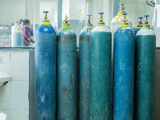"I do not think much of a man who is not wiser today than he was yesterday."
—Abraham Lincoln
(CIDRAP Business Source Osterholm Briefing) – In a few weeks, we will have lived through the first year of the first influenza pandemic of the 21st century. For many of us who have spent a great deal of our professional (and personal) time responding to this pandemic, the anniversary of its recognition will likely result in mixed, if not contradictory, feelings. Where did the last year go?
For many, it seems as though just yesterday we were trying to interpret the pandemic potential of those early cases of novel H1N1 infection in Mexico. On the other hand, if you were one of the many citizens, healthcare providers, or public health officials who was urgently seeking an almost nonexistent novel H1N1 vaccine dose for what seemed like months last fall, this last year no doubt felt like an eternity.
In danger of losing the lessons during the lull
Now, we find ourselves in a "flu lull." In fact, the past 3 months have been one of the quietest January-through-March human influenza periods in the past 40 years. The novel H1N1 virus has not made a return third-wave entrance—at least not yet—and the other, seasonal, influenza A strains have slowly disappeared, just as they did after the appearance of new pandemic strains in 1957 and 1968.
As I've noted in previous columns, we have to persevere in our pandemic preparedness efforts, despite ever-increasing pandemic preparedness fatigue among many of us and a sense by many colleagues that an influenza pandemic in a modern world (ie, our experience with the novel H1N1) may not be all that bad. While novel H1N1 activity continues to smolder in many parts of the world, including the United States, none of us can say if a significant third wave of novel H1N1 infection will occur in the next year. Nor can we predict when the next influenza pandemic will emerge. We can only say with clarity that another influenza pandemic will emerge some day in the future.
As Lincoln eloquently stated above, we must take the lessons learned over the past year from our pandemic experience and incorporate them into our plans for tomorrow if those plans are to be "wiser." I believe there are many such lessons, but one in particular seems most critical right now: We must maintain the support of our leaders and colleagues for pandemic preparedness efforts, or the many gains made in our plans and planning activities will be lost. If you consider the dollars that have gone into planning and response, such a waste should be untenable for most business leaders. But they might need some help understanding this point.
Didn't we learn from Katrina?
The backdrop isn't helping. A loud and ever-growing chorus of critics and skeptics believe that the novel H1N1 pandemic was much ado about nothing. A Mar 12 article, "The swine flu panic of 2009," which appeared in the popular German magazine der Spiegel, is a prime example of the widespread misinformation about what really happened in terms of human illness with novel H1N1. I'm aware this article has made the rounds in executive suites around the world. For the uninformed, the article and its simple, bold graphics about the purported flu scam perpetrated by public health and elected officials are no doubt convincing. But don't let your executives be fooled. There's much more to the story of novel H1N1—and it's critical that they know.
As I've stated before, public health officials had no other choice but to take seriously the threat of novel H1N1 as it emerged. As with a burgeoning hurricane a thousand miles out from shore, we don't know for certain where it will make landfall or what category it will be when it does. Katrina taught us well that history won't forgive us if we do not take aggressive steps to prepare once we have good information that a potential crisis is on the horizon.
If a hurricane never reaches a category 5 level or is downgraded before it makes landfall, we rejoice when lives and property are spared. With a pandemic, we would be just as culpable if we didn't take aggressive measures to save lives with the earliest evidence that an influenza pandemic is emerging. And we should rejoice if the number of deaths in the absence of an immediately available and effective vaccine is lower than previous pandemics. To be sure, our ability to forecast, be it for a hurricane or influenza pandemic, is less than perfect. Nevertheless, we must be as prepared as is reasonably possible.
Fortunately, new and more relevant information about the human toll is emerging from some systematic reviews of the novel H1N1 experience. These new findings should retire the outdated terminology of "mild, moderate, or severe" pandemics. A group (of which I am part) from the National Institutes of Health, International Society of Disease Surveillance, and the Department of Global Health at George Washington University has calculated preliminary estimates of mortality and years of life lost with the novel H1N1 pandemic (to date) in the United States and compared it with the three previous pandemics and seasonal influenza. An article describing our work was published this week in PLoS Current: Influenza.
In with the new, out with the old
Here's the gist: For eons, we've categorized the impact of previous pandemics and seasonal influenza using a concept of severity based largely on the estimates of how many people died. We traditionally describe the impact of a pandemic by contrasting the number of deaths during a pandemic with the number during seasonal influenza. (In the interest of time, I'll refer you to my Dec 14, 2009, column for a detailed explanation.)
Well, a death is not just a death. I think we can all agree that an influenza-related death of a functionally disabled 92-year-old is not equivalent to an influenza-related death of a healthy 23-year-old pregnant woman. In past pandemics or seasonal flu years, we have done little to distinguish between the two. Remember that more than 90% of all the deaths in a typical flu year occur in people over the age of 65. We have long needed a way to look at what kills people early in their lives, adds significant stress to our healthcare system, and robs society of productivity.
My colleagues and I tried to add critical perspective to comparing the human impact between pandemics and seasonal flu years. Our approach gives us a more meaningful way to both measure and compare pandemic and seasonal influenza based on the number of years of life lost (YLL), which takes into account the age of people who have died and thus the loss of their productive years. Our methodology is well explained in this CIDRAP News article, and I encourage you to read it. But in short, we found that the YLL burden of the 2009 pandemic to date may be as high as for the 1968 pandemic.
Here's a look at our comparisons:
In 2009, we also were fortunate to have the benefit of modern intensive care units (ICUs) in the developed world, without which the YLL would be even considerably higher. But this pandemic pushed many ICUs nearly to the breaking point. For example, a recent article in the Medical Journal of Australia pointed out the extraordinary conditions that ICUs in Australia and New Zealand witnessed last year as a result of H1N1. Further, the authors noted: "There is a real risk that the pandemic will affect Australia again next winter or earlier, and we feel the Australasian medical community should not be misled into believing that the pandemic (H1N1) 2009 influenza virus is not virulent and has not been responsible for significant mortality and morbidity in a population not normally affected."
Bottom line for organizations
We still don't know if we'll see a third wave of novel H1N1, but I have no doubt we'll see this virus in the next influenza season. We know another pandemic will happen and that it could show up in the next few years. We've learned valuable lessons to date. Our new way of looking at the impact of the 2009 pandemic clearly shows the effect pandemic influenza can have on people in their prime years of productivity.
We must make sure our senior management knows how important it is that we continue to be prepared for whatever comes next. We need to impress upon our leaders that we didn't overreact, that this pandemic had real consequence to society.
What's more, we need to ensure that the leaders of our organizations don't buy into the notion that we can predict when the next pandemic will arrive based on intervals between previous pandemics. After the pandemics of 1957 and 1968, many fell into the trap of thinking pandemics come every 10 years. But because we didn't experience the next pandemic for 40+ years, I fear we'll be lulled into thinking we're safe for another 40.
The 2009 novel H1N1 pandemic clearly pointed out how easily we can be surprised. It's critical that the next pandemic, whenever it emerges, not find us unprepared.


















